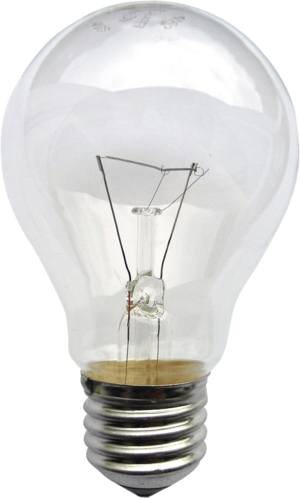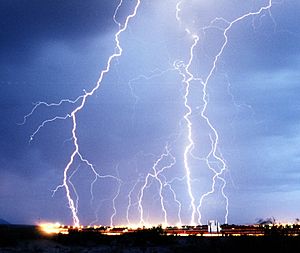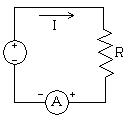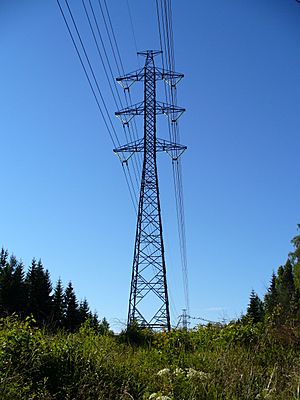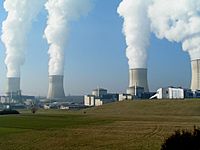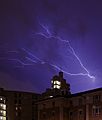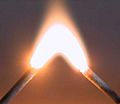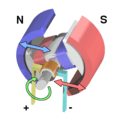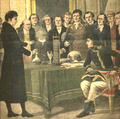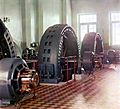Electricity facts for kids
Electricity is all about the presence and movement of tiny bits of electric charge. It's how we move energy around to power our homes, schools, and devices. The most common way we see electricity is as a flow of tiny particles called electrons through materials like copper wires.
Sometimes people use "electricity" when they really mean "electrical energy". But they are different! Think of electricity as the way electrical energy travels, like how ocean water carries wave energy. A material that lets electricity move through it easily is called a conductor. Metals like copper are great conductors. Materials that stop electricity from moving are called insulators. Plastic and rubber are good insulators.
Electrical energy can happen naturally, like lightning during a storm. Or, people can create it using machines called generators. We use electricity to power all sorts of machines and electronic devices. When electric charges aren't moving, it's called static electricity. When they are moving, it's called an electric current. Lightning is a powerful and dangerous example of electric current in nature.
Electricity can be very dangerous, especially near water. This is because water often has impurities like salt in it, which help electricity flow easily. Since the 1800s, electricity has become a huge part of our daily lives. Before that, it was mostly just a strange thing people saw during thunderstorms.
We can create electrical energy in a few ways. One common method is by moving a magnet near a metal wire. This is how big generators work in power stations. Another way is by mixing certain chemicals and metals in a battery. You can also make static electricity by rubbing two materials together, like a wool hat and a plastic ruler, which might even make a spark. And of course, solar cells can turn sunlight directly into electrical energy.
Electrical energy travels to our homes through wires from power stations. It powers everything from light bulbs and heaters to washing machines and computers. In factories, electricity runs huge machines. People who work with electricity and electrical devices are called "electricians".
Contents
How Electricity Works
There are two main types of electric charges: positive charges and negative charges. These charges either push away from each other or pull towards each other, even without touching. This happens because each charge creates an electric field around itself. An electric field is like an invisible force field. If you put another charge into this field, it will be pushed or pulled in a certain direction.
It's a bit like magnets: charges that are the same (like two positives or two negatives) will push each other away. Charges that are different (a positive and a negative) will pull towards each other. A simple way to remember this is: opposites attract, likes repel.
Everything in the universe is made of tiny particles. These particles have positive, negative, or neutral (no) charges. The positive particles are called protons, and the negative particles are called electrons. Protons are much heavier than electrons, but they have the same amount of charge, just opposite types. Because "opposites attract," protons and electrons usually stick together.
These protons and electrons form bigger particles called atoms and molecules. Atoms and molecules are super tiny – too small to see! Any large object, like your finger, has more atoms and molecules than we can count.
Because negative electrons and positive protons usually balance each other out, most big objects we see and touch are electrically neutral. "Electrically" means related to electricity, and "neutral" means balanced. That's why objects don't usually push or pull on us from a distance. The world around us is mostly balanced, or neutral, in terms of electric charge. Scientists are still trying to understand why this balance exists.
Electric Current Explained
In some materials, electrons can move around freely. In others, they are held tightly in place. A material that lets electrons move easily is called a conductor. Examples include copper, aluminum, silver, and gold. A material that holds electrons tightly is called an insulator. Examples are rubber, plastic, and wood. Copper is often used for electrical wires because it's a great conductor and there's a lot of it.
Inside a conductor, electrons usually bounce around randomly. But if an electric field is created inside the conductor, the electrons will all start moving in one direction. A battery can create this electric field. If you connect both ends of a wire to the two ends of a battery (called the electrodes), you create a loop called an electrical circuit. Electrons will then flow continuously around this circuit as long as the battery provides the electric field. This steady flow of electrons is called electric current.
Wires that carry electric current are often covered in an insulator like rubber. This is very important because bare wires carrying current can be dangerous. If a person or animal touches a bare wire, they could get a serious shock or even die, depending on how strong the current is. Always be careful around electrical sockets and any bare wires.
We connect electrical devices to circuits so that current flows through them. This current carries electrical energy, making the device do what we want. A light bulb is a simple example: current flows through a special wire inside it called a filament, making it glow. More complex devices, like an electric motor in a drill or a computer, also use electrical energy to work.
Important Electricity Terms
When you learn about electricity, you'll hear some special words. The study of how electricity works in circuits is called electronics. There's also a field called electrical engineering, where people design new things using electricity. These terms are key for understanding how it all works:
- Current is how much electric charge flows past a point. If 1 coulomb of charge moves in 1 second, the current is 1 ampere. We use an ammeter to measure current.
- Voltage, also known as "potential difference," is like the "push" that makes the current flow. It's the amount of energy each unit of electric charge has. If 1 coulomb of charge has 1 joule of energy, it has 1 volt of electric potential. A voltmeter measures voltage between two points.
- Resistance is how much a material "slows down" the flow of current. It reduces how fast the charge moves. If 1 volt of voltage pushes 1 ampere of current through a wire, the wire's resistance is 1 ohm. This relationship is known as Ohm's law. When current meets resistance, electrical energy is changed into other forms, like light, heat, sound, or movement.
- Electrical energy is the ability to do work using electric devices. Electrical energy can be moved from one place to another, like along wires or stored in a battery. It's measured in joules or kilowatt-hours (kWh).
- Electric power is how fast electrical energy is being used, stored, or moved. The flow of electrical energy along power lines is measured in watts. If electrical energy is being changed into another form (like light or heat), it's measured in watts.
How Electrical Energy is Made
Most electrical energy is created in places called power stations. Many power stations use heat to boil water, creating steam. This steam then spins a large machine called a steam engine, which is connected to a 'generator'. Inside the generator, coiled wires spin within a magnetic field. This spinning makes electricity flow through the wires, carrying electrical energy. This process is called electromagnetic induction, and it was discovered by Michael Faraday.
There are many ways to get the heat needed to make steam. Some heat sources are renewable energy, meaning they won't run out, like solar or geothermal energy. Others are non-renewable, meaning their supply will eventually be used up, like coal or natural gas.
Sometimes, we can use natural forces directly to turn a generator without needing heat. For example, wind power uses wind to spin turbines, and water power uses flowing water to turn generators.
Images for kids
-
Lightning and urban lighting are some of the most dramatic effects of electricity
-
Thales, one of the first known people to study electricity
-
Benjamin Franklin studied electricity a lot in the 1700s.
-
Michael Faraday's discoveries helped create electric motors.
-
An electric arc shows how powerful electric current can be.
-
The Italian physicist Alessandro Volta showing his "battery" to French emperor Napoleon Bonaparte in the early 1800s.
-
An early 20th-century alternator (a type of generator) from a hydroelectric power station in Budapest, Hungary.
-
Wind power is becoming more important in many countries.
-
The electric eel, Electrophorus electricus, can create its own electricity.
See also
 In Spanish: Electricidad para niños
In Spanish: Electricidad para niños


